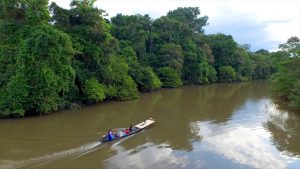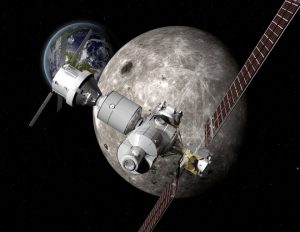“Nor is it to be thought, that man is either oldest or the last of Earth’s masters.” That is a quote from the story ‘The Dunwich Horror” by H.P. Lovecraft. Several of Lovecraft’s stories deal with the idea that millions of years ago, during the time of the dinosaurs or even earlier, there were intelligent creatures living here on Earth the remains of whose existence the passage of time has practically erased. The image below shows Lovecraft’s ‘The great race of Yith’ who lived in the area we call Australia during the Jurassic period, at least in the story ‘The Shadow out of Time’ that is.

Could that be true? Human history only goes back some 6 thousand years but the Earth is over 4 billion years old. If a pre-human species had built a civilization 100 million years ago how would we know? Would there be any traces remaining that we could find as evidence?
Two scientists, Gavin Schmidt of NASA’s Goddard Institute for Space Studies and Adam Frank of the Department of Physics and Astronomy at Rochester University are trying to answer those questions. Together they’ve written a paper ‘The Silurian Hypothesis: Would it be possible to detect an industrial civilization in the geologic record.’ The Silurians by the way are from another science fiction franchise. Back in the 1970s the British TV series Doctor Who ran a series of episodes where the Doctor encounters an ancient race of intelligent lizards who have been in hibernation since the days of the dinosaurs but are now waking up! The image below shows one of the silurians from Doctor Who.

O’k so the whole idea is inspired by science fiction but so what, so have airplanes and submarines. Science fiction has predicted many things that turned out to be true so lets take a good look at the Silurian Hypothesis by considering how a future intelligent species might discover evidence of our existence!
Now at first you might think that the biggest things humanity has built would survive the best. The pyramids have lasted now for 4 thousand years and they are still in reasonably good shape. But how recognizable will they be in 4 million years, that’s a thousand times their present age. That’s lot of erosion and remember what’s left will just be a pile of limestone, no different than the bedrock its sitting on!

O’k then what about something like the Golden Gate Bridge. Iron is stronger than limestone and you could never mistake a something like a bridge for a natural formation. That’s true, iron doesn’t erode, it rusts, faster than stone erodes and then it falls to pieces that can be dispersed by wind or water and just become a stray outcrop of iron ore.

Then let’s think bigger, how about entire cities like New York or Mumbai, in fact with sea level rise due to global warming both of those cities may soon be submerged into river deltas that would bury them in new rock formations. Couldn’t the fossil remains of New York City be found 10 million years from now?
Yes, it could, but you have to remember that New York City, indeed our entire industrialized society is only a little over 300 years old and that’s a very, very thin layer in the geologic record (the latest estimate for sediment deposition in the oceans is 1cm of thickness per 1000 years). Worse, our entire urban landscape today is only about 1% of the Earth’s total surface area making the odds of future, non-human geologists finding extensive evidence of our existence very low.
So do Schmidt and Frank think that there are any markers of our existence will survive for millions of years. Yes, but they’re not exactly flattering. For example, one is plastic. All of those bottles, cups and containers we just throw away are forming an unmistakable layer of artificial polyethylene and polypropylene covering much of the globe, making it both easier to spot and identify as a product of industrial civilization. The image below shows the plastic trash island in the Pacific Ocean, a huge amount artificial material that is now larger than any city.

Other indicators that Schmidt and Frank consider are subtler. The carbon deposited by our burning of fossil fuels will have an unnatural ratio of the isotopes C13 to C12 and similar unnatural ratios will occur to the elements strontium (Sr87 to Sr86) and osmium (Os187 to Os188). It is humbling indeed to think that for all of our importance, as we believe, if we were to destroy ourselves today (Nuclear War or Global Warming or etc) a few million years from now there would be little if anything remaining to prove that we had ever existed!
So perhaps we are not the first intelligent creatures to live on Earth, perhaps one day we will find the evidence to prove this. H. P. Lovecraft and Doctor Who have open minds, maybe we should as well!





































